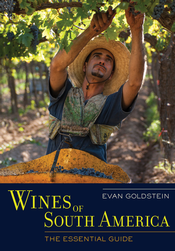English-language wine books are everywhere, with new ones vying for coveted space on bookstore shelves. Hardly a noted wine region hasn’t been covered in detail, except for South America. Now, however, noted Master Sommelier Evan Goldstein has written “Wines of South America,” released by the prolific wine book publisher, University of California Press.
Goldstein takes the reader on a wine tour of 10 South American countries, including the best known: Argentina, Chile, Brazil and Uruguay. Who knew, though, that there are six other countries producing wine in South America? Truth is, the six are really afterthoughts, since the real South American wine action, at least for North Americans, is coming from Argentina and  Chile and maybe Brazil and Uruguay. Still, the author should earn points for trekking to Paraguay to visit the country’s one winery that makes red wine from Grenache and Dornfelder, a German crossing that has had modest success in its native country.
Chile and maybe Brazil and Uruguay. Still, the author should earn points for trekking to Paraguay to visit the country’s one winery that makes red wine from Grenache and Dornfelder, a German crossing that has had modest success in its native country.
Beyond Paraguay, Goldstein lists 94 other South American wineries, mostly in Bolivia, but also Colombia, Ecuador, Peru and Venezuela. Bolivia’s total of 77 wineries is impressive until you realize that the bulk of the Bolivian grapes are intended for a different kind of grape drink than wine. “Only four of the country’s [Bolivia’s] nine departments have vineyards, and of their output, only half is intended for table wine,” says Goldstein. “The balance is used to make singani,” known elsewhere in South America as pisco, a popular spirit with a Muscat base.
By comparison, Uruguay boasts 270 wineries, Brazil has 1,162 (Goldstein writes that only 160 are focused on fine wine), while Chile checks in with 240 wineries. Argentina’s total of 1,320 wineries (approximately 370 are making fine wine), is the highest in South America. The take away from all these gee-whiz umbers is that in South America, pisco and singani rule. Of the thousands of wineries in South America, only a small percentage is exporting to North America and Europe. But that shouldn’t stop the curious wine drinker who is looking for new experiences.
The long chapter on Argentina begins with Goldstein’s pick for “Argentinean Game Changers,” a short list that includes Susana Balbo (winemaker and owner of Dominio del Plata), Nicolas Catena (patriarch of Argentine wine and founder of Catena Zapata), Roberto de la Mota (developer of Terrazas de la Los Andes and Cheval des Andes) and Julio Viola, a real estate agent, grape grower, vintner and restaurateur, who few people outside of Argentina have heard about. And there are region profiles with lists of recommended producers, followed by mini profiles of each winery. Chile gets the same treatment, with Goldstein’s “Game Changers” including Alvaro Espinoza (the Carmenere champion), Maria Luz Marin (part of the vanguard of winemakers that opened the San Antonio area), Aurelio Montes (Montes and Montes Alpha wines) and Pedro Parra (Chile’s “terroir whisperer”).
Grape detectives will find chapter 2 of interest. The usual vinifera suspects (Chardonnay, Pinot Gris, Cabernet Sauvignon, Merlot) are in most South American countries, but reading through the pages of this chapter my attention was drawn to red varieties Ancellotta (grown in Argentina and Brazil) and Arinaroa (Uruguay, Brazil and Argentina) and a small list of North American and hybrid grapes, including Concord, Isabella, Norton and Niagara, most of which are grown in Brazil. A few grapes that started out in France but never gained interest there, such as Egiodola, are having modest success in Brazil and Uruguay, while the noted Tannat grape of France’s Madiran has found a new home in Uruguay, Argentina and Brazil, with smaller acreage in Chile and Peru.
Goldstein provides other thumbnail sketches of South American grapes but, for me, the most interesting story centers around Bonarda. Argentina has more than 44,000 acres of Bonarda, making it the third most widely planted grape in that country. Fans of Italian Piedmont reds are familiar with the Bonarda grape, but Goldstein notes that the Bonarda of Argentina is not the same as the Bonarda of Piedmont. “It’s a different variety,” says Goldstein. “Argentinean Bonarda is what the French call Douce Noir (from the Savoie region) and what the rest of the world calls Corbeau, except in the United States, where we call it Charbono.
At the back of the book, not listed in the Contents as appendices or chapters, is a handy section on wine traveling that includes recommended wineries and why you should visit them (restaurant, artisan cheeses, caves, etc.), a short section on “Dining South American Style,” and more lists of wines, this time sorted by variety.
“Wines of South America” is not a glossy coffee table wine book; it has only a handful of snapshot-size black and white photos and 10 black and white maps that lack detail. And while it is not as small as a handbook, “Wines of South America” is a handy guidebook you can throw into your backpack or suitcase as a ready reference when traveling the wine roads of South America.
“Wines of South America: The Essential Guide,” by Evan Goldstein, hardcover, 306 pages, ISBN: 9780520273931
Wine Review Online Columnist Emeritus Gerald Boyd contributes book reviews in this space on a regular basis from his so-called “retirement.”
6
